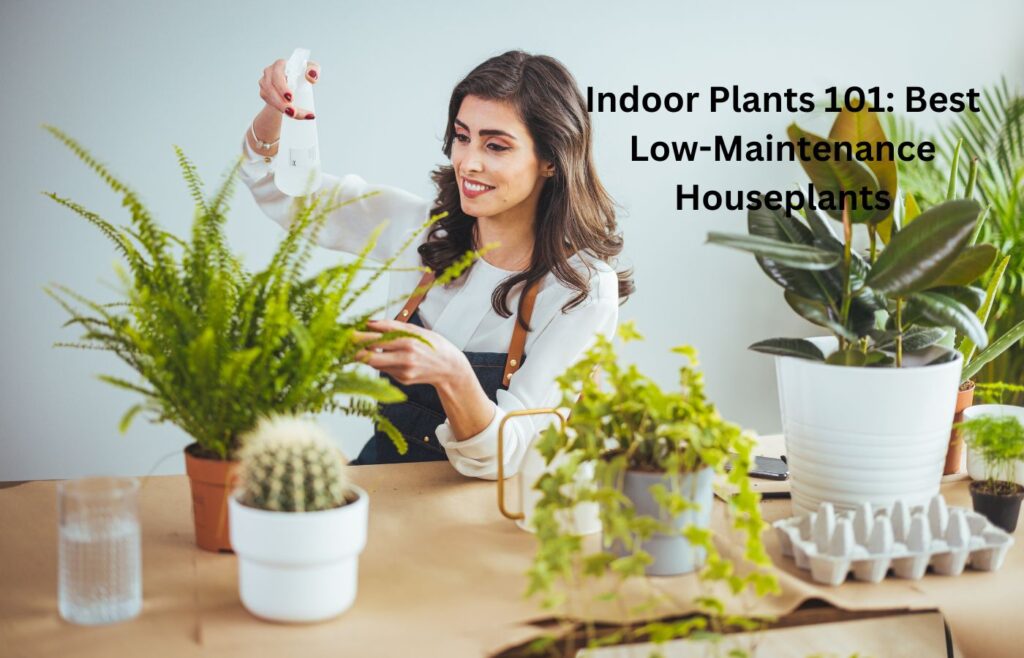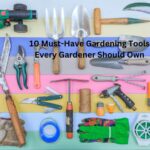Introduction – Low-Maintenance Houseplants
The attractiveness of houseplants has grown in recent years, attracting enthusiasts with its combination of aesthetic value and health benefits. In the middle of the fast-paced modern world, houseplants like flowers provide a peaceful retreat, fresh air, and a breath of fresh air to our homes.
But, for those just starting, the idea of indoor gardening and low-maintenance houseplants might be overwhelming, with all the unknowns regarding plant care, upkeep, and environmental compatibility. This guide aims to simplify the process by revealing a collection of the top low-maintenance houseplants that require little care and are perfect for beginners.
This guide will lead you through the lush landscape of low-maintenance houseplants, covering everything from the hardy Snake Plant to the fashionable Peace Lily and providing information on each plant’s characteristics, needs, and benefits.
You can choose low-maintenance houseplants that will add lush beauty to your space, whether you’re in a sunny apartment or a shady business cubicle. Come with us on this botanical adventure as we learn how to grow flourishing indoor gardens, bringing the beauty of nature’s foliage into our homes for the rest of time. The fun of cultivating indoor lives begins with plants here at Indoor Plants, One Zero One.
Benefits of Indoor Plants – Low-Maintenance Houseplants
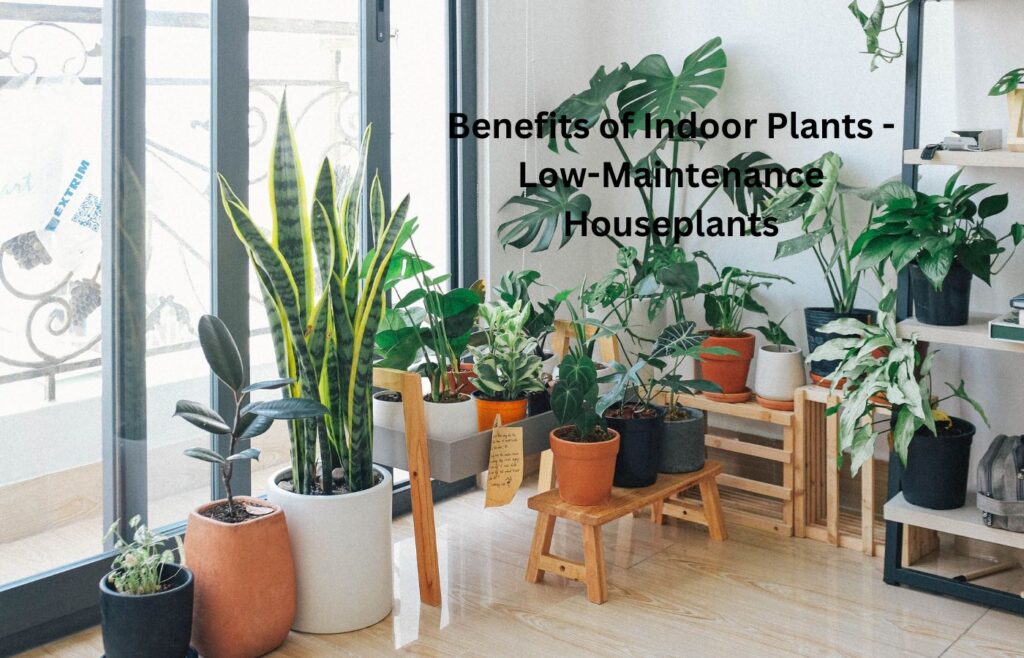
In recent years, low-maintenance houseplants have gained popularity as an aesthetic component that can significantly improve our general health. Various clinical evidence shows their benefits go beyond just looking good; they also enhance air quality, mental wellness, and productivity.
Indoor plants and low-maintenance houseplants improve air quality by acting as herbal purifiers, removing pollutants, and releasing oxygen. According to studies backed by NASA and other medical institutions, spider plants, peace lilies, and other common houseplants may be releasing toxic levels of formaldehyde, benzene, and trichloroethylene into indoor air.
Through photosynthesis, those plants effectively remove pollutants from the air, creating a healthier environment for people to live and work in.
In addition, research has shown that having low-maintenance houseplants in the house has a significant impact on people’s mental health. According to studies, connecting with houseplants can improve mood, embellish cognitive traits, and reduce stress. Seeing the interior vegetation has a soothing influence on the mind, encouraging emotions of peace and oneness with nature.
The therapeutic effect of indoor horticulture has driven the inclusion of flowers into recuperation situations, such as hospitals, rehabilitation facilities, and workplaces. These flowers promote rest and productivity.
By adding life, texture, and color to indoor places like homes and offices, indoor plants help create more aesthetically pleasing interiors. The architectural elegance of a towering Fiddle Leaf Fig and the beautiful leaves of a trailing Pothos are just two examples of how indoor plant life may enhance an interior arrangement.
People may make their living spaces uniquely theirs by adding low-maintenance houseplants in unexpected places or coordinating them with existing decor. This is a great way to show off one’s style and personality.
Crucially, houseplants are versatile and may flourish in various interior settings using low-maintenance houseplants, from brightly light living rooms to sluggishly lit office cubicles. People may effectively add greenery to their surroundings, no matter where they are, by choosing low-maintenance houseplants compatible with the lighting conditions and the space they have. Because of their adaptability, indoor flowers may bring the beauty and energy of nature into the homes, offices, and condos of those who live in urban environments.
In the end, indoor plant life offers a mess of blessings that increase past mere ornament. From purifying the air we breathe to uplifting our temper and improving productivity, those inexperienced companions have become essential elements of contemporary living.
Supported by medical studies and adaptable to various indoor environments, indoor low-maintenance houseplants have the electricity to convert our homes and places of work into colorful, healthy sanctuaries wherein the splendor of nature flourishes.
Factors to Consider Before Choosing Indoor Plants – Low-Maintenance Houseplants

There are many things to remember before you start your indoor gardening experience that will impact how happy and successful your plants are. Having a good grasp of those factors and making educated choices can assist you in selecting the ideal low-maintenance houseplants for your living arrangement and way of life.
Before everything else, keep in mind the indoor lighting conditions. Different plants need different amounts of light, from low, indirect to bright, direct sunlight. Consider the direction and strength of the sun at various times of the day to evaluate the herbal light accessible in your area.
Even though north-facing windows may provide lower light levels, south-facing windows usually get the most sunlight. To ensure your plants get enough light to grow, you should check what kinds of light indoor flowers need and compare them to the light in your room.
When choosing low-maintenance houseplants, watering wishes are equally important. Many plant species have specific watering needs; some thrive in consistently moist environments, while others do well in less moisture. Do your homework on the particular watering needs of each low-maintenance houseplants you intend to bring home before you do so, and set up a regular watering schedule that considers soil moisture, humidity levels, and the plant’s size.
Striking a balance and not drowning your low-maintenance houseplants with excessive moisture is crucial, as overwatering is a common mistake made by indoor gardeners.
When choosing low-maintenance houseplants, consider the available space carefully. Take stock of the dimensions and arrangement of your indoor space, including the floor plan, available shelves, and hanging space.
Think about how big the plants you want will be when they’re fully grown, and make sure they won’t get in the way of anything. Remember that several low-maintenance houseplants can create an elegant appearance, and choose flowers that go with your current style of decor and layout.
Finally, before you buy any low-maintenance houseplants, research their specific care needs and see how well you can meet them. While some plants survive with little care, others necessitate regular trimming, repotting, or fertilizing. When deciding on indoor flower varieties, consider your gardening experience, schedule, and way of life.
Also, choose varieties compatible with your preservation abilities and available possibilities. Embrace the beauty and benefits of indoor gardening without being overwhelmed by excessive maintenance requirements by selecting low-renovation houseplants that suit your lifestyle.
In conclusion, consider light conditions, hydration preferences, space considerations, and restoration needs when selecting indoor low-maintenance houseplants. You can choose the right plants for your indoor environment and build a flourishing indoor garden that adds beauty and joy to your living space by learning about those factors and making educated decisions.
Top Low-Maintenance Houseplants for Beginners
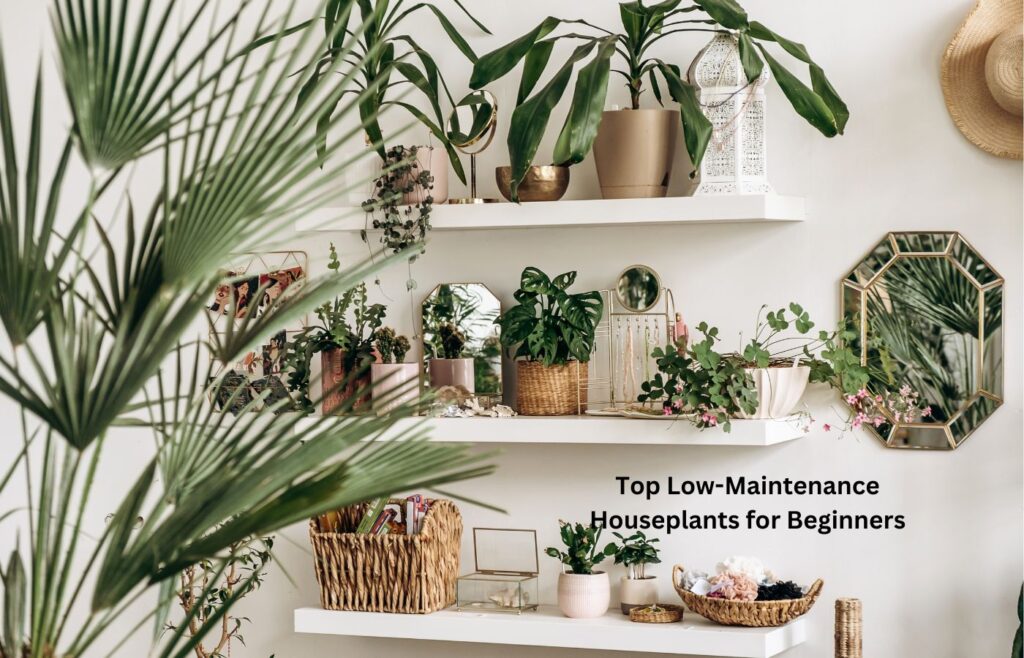
Snake Plant (Sansevieria trifasciata):
The Snake Plant, formally known as Sansevieria trifasciata or Dracaena trifasciata, is easily identifiable by its distinctive appearance. The foliage is long and sword-shaped, and it has varied styles. The architectural appeal these leaves can provide to indoor spaces can be seen when they develop erect or in a rosette arrangement.
Snake plants require little light and a moderate environment to flourish, making them ideal houseplants for offices or other spaces with limited natural light. They can be drought-tolerant and susceptible to root rot if watered too frequently, so it’s best to water them infrequently.
To avoid soggy soil, they let water drain out of the soil when watering. To further prevent water from pooling around the roots, Snake Plants like soil that drains properly.
The exceptional air-purifying capabilities of the Snake Plant are among its most notable advantages. Indoor air quality is improved, and a healthier home is created due to the correct removal of formaldehyde, benzene, xylene, and trichloroethylene pollutants.
Snake Plants are an excellent choice for those who aren’t green thumbs or who just don’t have the time to devote to regular plant maintenance because of their extreme resilience. For indoor gardeners who value both form and function, the Snake Plant is an excellent choice due to its low maintenance requirements and high visual appeal.
Pothos (Epipremnum aureum):
A popular choice for indoor gardens, Pothos (Epremnum aureum) is recognized for its lush trailing tendrils and coronary heart-shaped leaves. Whether housed in pots or trained to scramble along trellises or cupboards, its draping foliage adds a graceful touch to any setting.
With the right care, pothos may flourish in a broad spectrum of light conditions, from low to slightly mild, making it suitable for various indoor settings. If you overwater Pothos, it will suffer from root rot, so let the soil dry out between waterings. Following a regular watering schedule, you can keep your plant healthy and strong.
Its capacity to cleanse the air within is one of Pothos’s most remarkable benefits. Improved air quality and a healthier environment result from eliminating typical indoor pollutants like benzene and xylene. Furthermore, Pothos is versatile and does well in various indoor environments, from bright, sunny rooms to dark office spaces or restrooms. Indoor gardeners looking for a low-maintenance plant that adds beauty and functionality to their space will find Pothos an ideal choice due to its durability and air-purifying properties.
ZZ Plant (Zamioculcas zamiifolia):
Zamioculcas zamiifolia, most often known as the ZZ Plant, is an upright-growing plant with stunning, sleek, darkish-inexperienced foliage. Many people choose it for their homes and offices because of its distinctive style, which adds sophistication to any indoor area.
The ZZ Plant requires very little maintenance, making it an ideal choice for individuals who are too busy or need more time to tend to a garden. As a result, it may survive and even flourish in low-light settings where other vegetation types may be actively competing for resources. The ZZ Plant can withstand dry conditions and retains water in its extensive root system, so it rarely needs watering. To keep the plant healthy and free of root rot, it is crucial to water the soil until it dries out.
The ZZ Plant’s resilience and longevity are two of its greatest strengths. Its ability to tolerate low humidity and varying temperatures makes it an excellent pick for indoor gardeners seeking a trouble-free plant. Its adaptability to dim lighting also makes it an excellent choice for offices or other spaces with limited natural light. The ZZ Plant is an adaptable houseplant that requires little in the way of maintenance and looks great doing it.
Spider Plant (Chlorophytum comosum)
The gracefully arching leaves and spider-like plantlets that drape from long, narrow stems make the Spider Plant, formally known as Chlorophytum comosum, stand out. A favorite among those who prefer to grow indoors, this lovely plant adds a whimsical appeal to any space.
Spider plants do best in bright, indirect light but will survive in moderate to dim settings with proper care. Sunlight can burn the fragile leaves; therefore, keeping them out of direct sunlight is important. The ideal watering conditions for spider plants are slightly moist soil that is not soggy. Let the top inch of soil dry out in between waterings to avoid root rot and maintain optimal fitness.
The spider plant’s ability to greatly improve air quality is one of its many wonderful qualities. Indoor air quality is improved, and healthier living environments are promoted by effectively removing pollutants like formaldehyde, xylene, and carbon monoxide. Furthermore, Spider Plants are perfect for first-timers or people who are often on the go because they are easy to clean. Spider plants are a great option for anyone seeking to add some greenery to their indoor space because of their low maintenance requirements and ability to filter the air.
Peace Lily (Spathiphyllum)
Spathiphyllum, the technical name for the peace lily, is well-known for its stunning appearance. It has chic white flowers that shoot upwards from glossy dark green foliage. It is a popular choice among indoor gardeners due to the elegant way it brings a sense of calm and refinement to any room.
Regarding care, the Peace Lily does best in bright, indirect light. However, it can manage lower light levels. Please keep it away from direct sunshine to protect its leaves from scorching. The Peace Lily does best when kept equally moist, but to avoid root rot and overwatering, let the top inch of soil dry out in between waterings. Furthermore, Peace Lilies are ideal for highly humid areas like kitchens or bathrooms because they can detect higher humidity levels.
The Peace Lily’s ability to remove pollutants from indoor air, such as formaldehyde, benzene, and ammonia, is one of its first-rate advantages. Its ability to filter the air makes a home healthier for its inhabitants. The Peace Lily is a wonderful indoor plant option for many locations, including homes, workplaces, hospitals, and classrooms, because of its adaptation to indoor conditions. Any indoor garden would benefit from adding a Peace Lily due to its adaptability, durability, and air-purifying properties.
Essential Care Tips for Low-Maintenance Houseplants
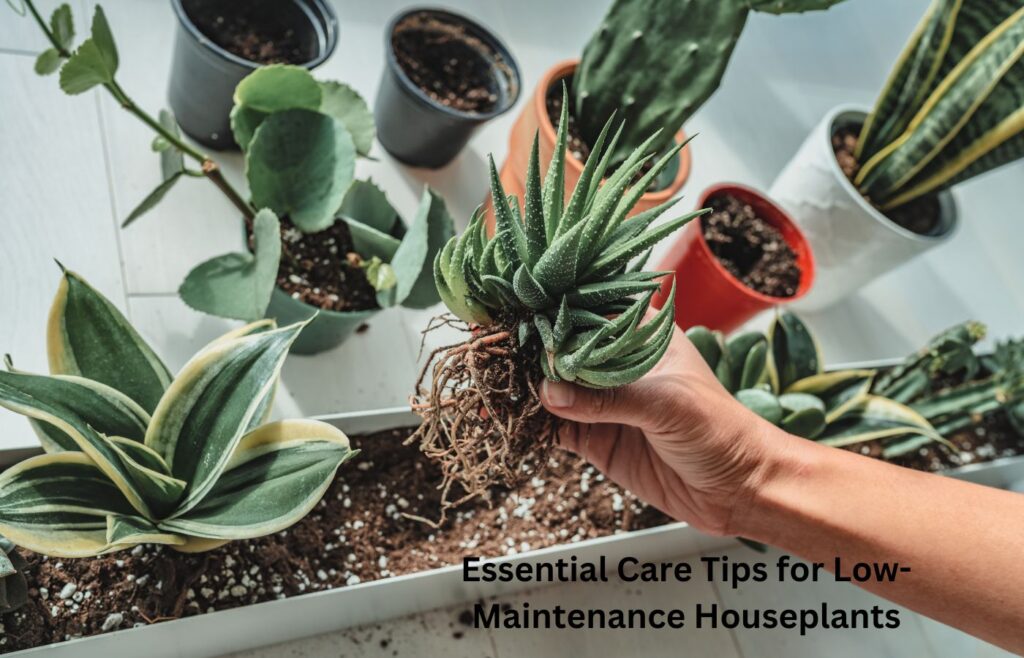
Following a few critical care guidelines that meet the primary needs of low-maintenance houseplants is essential to ensuring their fitness and vitality. If you want your low-maintenance houseplants to flourish, it helps to know what they need in terms of light, water, soil, temperature, humidity, and pest control.
Light:
To place your plants in the optimal light, you must be familiar with the difference between direct and indirect light. While direct sunlight can burn leaves, oblique light provides a better-diffused light that is softer and more effective. Ensure the local flora receives the exact amount of light they require by evaluating the herbal lighting in your region. If you want your plants to develop evenly and not tilt towards the light, you should rotate them occasional
Watering:
The best way to avoid drowning or overwatering your plants is to create a watering schedule according to their needs. Check the soil’s moisture level before watering by sticking your finger to your first knuckle. The soil should be watered when it feels dry. Instead of sticking to a strict schedule, adjust the watering frequency according to the plant’s needs, the length of the pot, and the surrounding conditions. Never use colder water than room temperature, and always check for adequate drainage to avoid flooding.
Soil:
Avoiding waterlogged conditions, which can lead to root rot, requires using a potting mix that drains effectively. Find a combination that is lightweight and porous so that water may drain easily while still retaining moisture. When plants outgrow their containers, it may be time to repot them with new soil and more room for their roots to spread. Ensure water doesn’t pool at the base using containers with holes cut into them.
Temperature and Humidity:
If you want your houseplants to flourish, you must ensure the temperature and humidity are right. Daytime temperatures between 65 and 75 degrees Fahrenheit (18 and 24 degrees Celsius) and somewhat lower nighttime temperatures are ideal for most houseplants. Keep plants away from drafts, vents, and heating sources to stabilize their temperatures. In addition, remember to increase humidity levels, particularly in the dry winter months, by spraying foliage frequently, placing plants on a pebble tray with water, or using a humidifier.
Pest Control:
Preventing infestations of harmful pests and diseases requires early identification of common pests and illnesses. Check plants often for signs of pests, including scale insects, mealybugs, aphids, and spider mites. When pests are found, it’s important to separate the plants that have been harmed and treat them with appropriate chemicals or natural remedies. To reduce the likelihood of pest infestations, take preventative actions including cleaning plant foliage often, maintaining adequate airflow, and avoiding overcrowding.
By following those important care instructions, you may make a loving environment for your low-maintenance houseplants. This will ensure their longevity and vitality while allowing you to enjoy the beauty they provide to your interior space.
Troubleshooting Common Issues – Low-Maintenance Houseplants

If you want your low-maintenance houseplants to stay healthy, you must know how to fix the most common issues. Your low-maintenance houseplants can recover to their optimal fitness level if you recognize the signs of trouble and investigate their origins.
Yellowing Leaves:
The typical sign of yellowing leaves can indicate overwatering, underwatering, or nutrient shortages, among other things; when plants absorb more water than they can utilize, a condition known as overwatering happens, which causes nutrients to seep out of the soil and the leaves to turn yellow.
Allowing the soil to dry out between waterings and adjusting your watering frequency can help alleviate overwatering. Conversely, when plants are submerged in water for too long, they become too dry to absorb vital nutrients, leading to leaf yellowing. Increasing the watering frequency and ensuring the soil is thoroughly hydrated will help with underwatering. Also, a lack of nitrogen, iron, or magnesium might cause the leaves to turn yellow. A balanced, water-soluble fertilizer can help plants grow well by resupplying essential nutrients.
Pest Infestations:
Aphids, spider mites, and mealybugs are common pests, but it’s important to know how to spot and identify odd ones. Aphids, which are little, smooth-bodied insects, feed on plant sap and cause yellowing of leaves and deformed growth in plants. Infestations of spider mites, little spiders, cause stippled leaves and webs on infested plants because they feed on plant sap. Little cottony bugs called mealybugs feed on plant sap and produce honeydew, attracting ants and contributing to the growth of sooty mold.
Physically removing pests from plant life using moderate water circulation or a soft brush is an effective method for controlling aphids, spider mites, and mealybugs. Another option is to carefully follow the instructions on the manufacturer’s label when applying insecticidal soap or neem oil to the damaged plants. To avoid reinfestation, repeat treatments as needed to eliminate pests.
Root Rot:
When plants are overwatered, have poor drainage, or have their soil compacted, it can cause a fungal disease called root rot, which kills the plant by eating away at its roots. Prevent root rot using pots with holes for drainage and potting mixes that drain effectively. To prevent watering your plants too much, wait for the soil to dry out in between waterings and modify the watering frequency according to their needs.
If you notice any signs of root rot, carefully remove the plants from their containers and examine the roots for damage. Remove diseased or rotten roots with sterile shears and plant in new soil. A fungicide will stop the spread of the same fungus and promote root growth. To avoid root rot in the future, adjust your watering techniques and improve drainage.
You may improve the vitality and health of your houseplants by fixing typical problems like pest infestations, root rot, and yellowing foliage. Inviting beauty and verdant life into your home, your plants will flourish with attention and nurturing.
Conclusion – Low-Maintenance Houseplants
Ultimately, it comes down to knowing what low-maintenance houseplants want, how to fix common problems, and giving them your full attention. With the correct lighting, watering, soil control, temperature, humidity, and pest management, you can cultivate an ideal setting for your houseplants to flourish.
To maintain the health and vitality of your flowers, it is essential to identify and treat common issues such as leaf yellowing, pest infestations, and root rot. To keep problems from worsening and ensure your indoor grass stays healthy for a long time, be proactive and act quickly.
Nowadays, low-maintenance houseplants do more than just provide aesthetic value; they also help with air quality, mental health, and overall pleasure. They bring a little piece of nature inside, assisting people to relax and feel more at one with nature.
An enjoyable project that offers many benefits with little effort is to incorporate low-upkeep houseplants into your home or office environment. You can bring the beauty of nature into your home with an indoor garden, and it will provide you unending joy and pleasure if you give it the attention and care it needs to thrive.
How often should I water my low-maintenance houseplants?
It's essential to allow the soil to dry out between waterings. Typically, watering once every 1-2 weeks is sufficient, but it depends on factors like plant type, pot size, and environmental conditions.
What light conditions do low-maintenance houseplants prefer?
Low-maintenance houseplants generally prefer bright, indirect light. However, many can also tolerate low-light conditions, making them suitable for various indoor environments.
How do I prevent pests from infesting my low-maintenance houseplants?
Regularly inspect your plants for signs of pests such as aphids, spider mites, or mealybugs. Keep plants clean by wiping leaves with a damp cloth and isolate any infested plants immediately to prevent the spread of pests.
What should I do if my low-maintenance houseplant’s leaves turn yellow?
Yellowing leaves can be a sign of overwatering, underwatering, or nutrient deficiencies. Adjust your watering frequency, ensure proper drainage, and consider fertilizing your plants to address nutrient deficiencies.
When should I repot my low-maintenance houseplants?
Repot your plants when they outgrow their containers or if you notice roots growing out of the drainage holes. Choose a slightly larger pot with fresh, well-draining soil to accommodate growth.
How do I propagate low-maintenance houseplants?
Propagation methods vary depending on the plant type but commonly include stem or leaf cuttings, division, or offsets. Follow specific propagation techniques for each plant species to ensure successful propagation.
The article “Indoor Plants 101: Best Low-Maintenance Houseplants” is written by HomeGardenIdeas.com. Our team of passionate writers and experts shares tips and inspiration on gardening, home improvement, and design to help you create your dream space.

